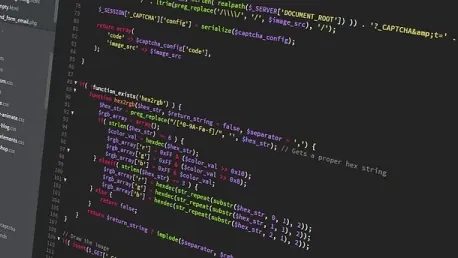The rise of AI tools in the coding world has revolutionized the way developers approach their work, making coding faster and more efficient. With tools like ChatGPT and GitHub Copilot, developers can now write code faster, automate repetitive tasks, and even generate entire frameworks from scratch. However, this increased reliance on AI comes with its own set of challenges, particularly in the realm of application security. While these tools offer numerous advantages, they also introduce significant risks that need diligent management. As these AI tools become more embedded in everyday coding practices, it’s essential to understand both their benefits and the potential security pitfalls they may bring.
The Popularity and Usage of AI in Coding
AI tools have become increasingly popular among developers. According to a recent StackOverflow survey, 76% of developers either use or intend to use AI tools for their work. These tools offer numerous advantages, such as speeding up the coding process and reducing the time spent on mundane tasks. By automating repetitive tasks, AI allows developers to focus on more complex and creative aspects of their projects. However, the widespread adoption of AI in coding also raises significant security concerns. These tools, while efficient, lack the bespoke understanding and contextual awareness that human developers possess. This gap can lead to the generation of code that is functional but not necessarily secure, necessitating a closer scrutiny of AI-generated code.
Despite these benefits, developers must be vigilant in reviewing AI-generated code to ensure it does not introduce vulnerabilities. The pace and ease with which AI can produce code make it tempting for developers to use AI outputs without thorough vetting. However, such practices can compromise security and lead to the introduction of vulnerabilities that might not be immediately apparent. Developers must, therefore, adopt a balanced approach to using AI tools — leveraging their productivity benefits while maintaining rigorous security standards.
Security Risks with AI-Assisted Coding
One of the primary concerns with AI-assisted coding is the potential compromise of application security. AI tools generate code based on pattern recognition and analysis of existing data. This process, while rapid and efficient, lacks genuine comprehension, which can result in the inadvertent introduction of common vulnerabilities such as SQL injections, cross-site scripting (XSS), and session hijacking. These vulnerabilities can be exploited by malicious actors, leading to significant security breaches that can compromise entire applications and sensitive user data.
Another risk is the blind trust that some developers place in AI-generated code. Copying and pasting code without thorough review can result in the embedding of legacy vulnerabilities and outdated practices. AI tools do not have the critical judgment necessary to produce secure and context-specific code, making human oversight essential. Developers need to ensure they review and understand the code generated by AI, employing thorough testing and validation processes to catch potential security flaws. Adopting an approach that combines human expertise with AI capabilities can mitigate these risks while harnessing the productivity benefits of AI tools.
Library and Framework Selection Risks
AI tools often recommend libraries or frameworks based on historical data. While this can be helpful, it also poses risks if the recommended libraries are outdated or lack recent security patches. Using such libraries can compromise the security of the entire application, as they may contain known vulnerabilities that have not been addressed. Developers should be cautious and conduct thorough vetting of any third-party libraries or frameworks recommended by AI tools. Checking for recent updates, security patches, and community reviews helps ensure that the components they use are secure and up-to-date.
To mitigate these risks, developers should implement a meticulous process for vetting third-party libraries or frameworks. This involves not only reviewing the historical usage and reputation of these components but also keeping an eye on recent developments and feedback from the developer community. Comprehensive vetting practices are crucial in maintaining the integrity and security of applications. Developers should adopt a proactive approach in monitoring and updating their libraries, ensuring that they stay ahead of potential vulnerabilities and security flaws.
Managing AI-Related Risks
Despite the security risks associated with AI-assisted coding, completely banning AI tools would be counterproductive. Instead, developers and organizations should focus on managing these risks effectively. One way to do this is through a combination of static application security testing (SAST) and dynamic application security testing (DAST). SAST helps detect vulnerabilities early in the development process by analyzing the source code, while DAST ensures that the live application functions securely by testing it through real-world attack scenarios. This combination of testing methodologies serves to identify and address potential security issues comprehensively throughout the development lifecycle.
Another effective strategy is software composition analysis (SCA), which involves vetting third-party libraries and dependencies selected based on AI recommendations. SCA helps ensure the security of these components and prevents the introduction of vulnerabilities. By incorporating SCA into their security protocols, developers can better manage the risks associated with using third-party libraries and frameworks. Such vigilance ensures that any external code integrated into their applications meets stringent security standards.
Establishing Clear Guidelines and Policies
To ensure responsible and secure use of AI in coding practices, organizations should establish clear guidelines and policies. This includes developing a list of approved AI tools that have been vetted for security and instructing developers on what data can be safely input into these tools. For instance, sensitive or proprietary code should not be input into public AI platforms to avoid potential data leaks. By providing developers with clear boundaries and best practices, organizations can help mitigate the risks associated with AI-assisted coding.
Establishing these guidelines involves continuous education and training for developers on the best practices of using AI tools responsibly. Organizations should foster a culture of security awareness, ensuring that developers are updated on the latest security threats and mitigation techniques. Regular audits and reviews of AI tools and practices can further strengthen security protocols, ensuring they evolve with emerging risks. By integrating these comprehensive measures, AI tools can be utilized effectively while maintaining a robust focus on application security.
The Role of Human Oversight
While AI tools can significantly enhance productivity, they cannot replace the critical judgment and contextual understanding that human developers bring to the table. Human oversight is essential to ensure that AI-generated code is secure and reliable. This includes thorough code reviews, security testing, and continuous monitoring of the application. Developers should approach AI-generated code with a critical eye, combining the strengths of AI with human expertise to achieve a balance between efficiency and security.
Training developers to recognize the limitations of AI tools and to maintain a high standard of vigilance when reviewing AI-generated code is crucial. Regular code reviews and peer assessments can help identify potential security issues that AI tools might miss. By fostering collaboration and continuous feedback among developers, organizations can create a more secure coding environment. This integrated approach reinforces the significance of human oversight, ensuring that both AI-generated and developer-written code meet the highest security standards.
Integrating Security into the Development Lifecycle
The emergence of AI tools in the coding landscape has drastically transformed the way developers carry out their tasks, rendering coding swifter and more streamlined. With innovations like ChatGPT and GitHub Copilot, developers can now efficiently write code, automate mundane tasks, and even create whole frameworks from the ground up. Nevertheless, this growing dependence on AI ushers in its own set of obstacles, particularly regarding application security. Despite the numerous benefits these tools offer, they also pose considerable risks that require careful oversight. As these AI solutions become more ingrained in daily coding routines, it’s crucial to comprehend both their advantages and the potential security vulnerabilities they might introduce. Understanding these aspects will help developers leverage AI tools effectively while maintaining robust security measures. Only by balancing the benefits with the risks can the full potential of AI be realized in the coding world.









